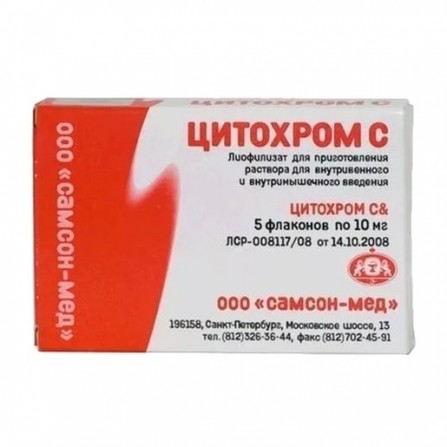Cytochrome-C lyophilisate in in, intramuscularly 10mg 5ml N5
Condition: New product
1000 Items
Rating:
Be the first to write a review!

More info
Active ingredients
Cytochrome C
Release form
Lyophilisate
Composition
Lyophilisate for preparation of solution for in / in and in oil of introduction of 1 fl. cytochrome C 10 mg.
Pharmacological effect
Cytoprotector. It is a high molecular weight iron porphyrin compound, which is isolated in the form of a purified crystalline substance, for example, from cattle myocardium. It is a conjugated protein, similar in structure to hemoglobin, consists of a heme and a single peptide chain (apocytochrome C). Cytochrome C plays an important role in biochemical redox processes in virtually all aerobic organisms. These reactions occur with the participation of two mitochondrial enzymes: cytochrome oxidase and cytochrome reductase. Heme exhibits the properties of either a donor or an electron acceptor. It has a high chemical activity with respect to the utilization of oxygen radicals, such as superoxide or hydrogen peroxide, which is a strong oxidizing agent. Heme metabolites act as "traps" for the peroxide radical. It is established that in the lens affected by cataracts, the concentration of cytochrome C is reduced. Cytochrome C is unable to sufficiently penetrate into the cornea as a whole molecule. This becomes possible only after cleavage of the peptide chain to a heme-containing nanopeptide, which freely penetrates the cornea. Inhibition of oxidative processes in all tissues located in front of the lens (including the cornea and intraocular fluid) is of great importance for suppressing the development of cataracts, since ultraviolet radiation causes chain reactions in these tissues with the formation of free oxygen radicals, which, as has been proven may cause clouding of the lens. Heme-containing cytochrome C has the ability to neutralize free oxygen radicals in certain redox processes and thus prevent the development of cataracts.
Indications
Conditions accompanied by tissue hypoxia (poisoning with hypnotic drugs, carbon monoxide, luminescent gas, ischemic, dystrophic, infectious-inflammatory, toxic myocardial damage, chronic circulatory failure,disorders of cerebral and peripheral circulation, pneumonia, respiratory failure. prevention of tissue damage during anesthesia, to support the body in the pre- and postoperative periods during operations on the chest. cataract treatment (as part of combination therapy).
Contraindications
Hypersensitivity to horse serum, pregnancy, lactation (breastfeeding).
Use during pregnancy and lactation
In / in the introduction of cytochrome C is contraindicated during pregnancy and lactation (breastfeeding).
Dosage and administration
Individual, depending on indications and the applied dosage form.
Side effects
Allergic reactions: with the rapid on / in the introduction - flushing of the skin, itching, urticaria, chills, hyperthermia. with local application in ophthalmology - conjunctival hyperemia, short-term burning sensation.
special instructions
Allergic reactions: with the rapid on / in the introduction - flushing of the skin, itching, urticaria, chills, hyperthermia. with local application in ophthalmology - conjunctival hyperemia, short-term burning sensation.






